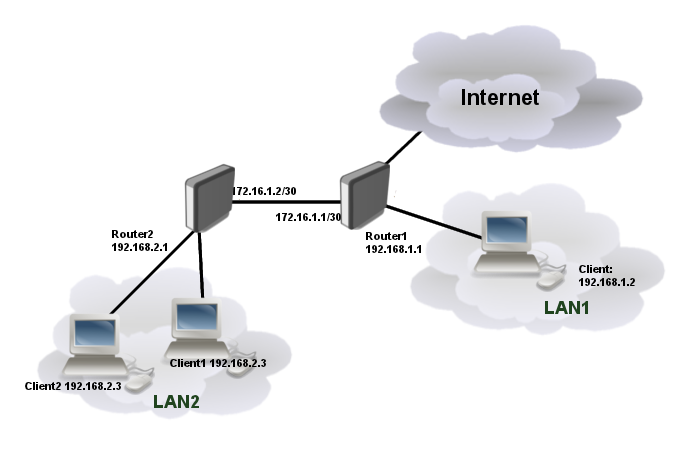Manual:Simple Static Routing: Difference between revisions
No edit summary |
|||
| Line 1: | Line 1: | ||
== Introduction == | == Introduction == | ||
Lets make a simple routing setup illustrated in image below | |||
[[Image:SR1.png]] | [[Image:SR1.png]] | ||
Ether1 of Router1 is connected to ISP and will be the gateway of our networks. Router2 is connected to ether2 of Router1 and will act as a gateway for clients connected to it from LAN2. Router1 also connects one client to ether3. Our goal is to create setup so that clients from LAN1 can reach clients from LAN2 and all of them can connect to internet. | |||
==Configuration== | |||
Lets consider that ISP gave us an address 10.1.1.2/30 and gateway is 10.1.1.1 | |||
Router1: | |||
<pre> | |||
/ip address | |||
add address=10.1.1.2 interface=ether1 | |||
add address=172.16.1.1/30 interface=ether2 | |||
add address=192.168.1.1/24 interface=ether3 | |||
/ip route | |||
add gateway=10.1.1.1 | |||
add dst-address=192.168.2.0/24 gateway=172.16.1.2 | |||
</pre> | |||
Router2: | |||
<pre> | |||
/ip address | |||
add address=172.16.1.2/30 interface=ether1 | |||
add address=192.168.2.1/24 interface=ether2 | |||
/ip route | |||
add gateway=172.16.1.1 | |||
</pre> | |||
If you look at configuration then you will see that on Router1 we added route to destination 182.168.2.0/24. It is required for clients from LAN1 to be able to reach clients on LAN2. On Router2 such route is not required since LAN1 can be reached by default route. | |||
{{cont}} | |||
[[Category:Manual]] | [[Category:Manual]] | ||
[[Category:Routing]] | [[Category:Routing]] | ||
[[Category:Examples]] | [[Category:Examples]] | ||
Revision as of 16:11, 5 August 2011
Introduction
Lets make a simple routing setup illustrated in image below
Ether1 of Router1 is connected to ISP and will be the gateway of our networks. Router2 is connected to ether2 of Router1 and will act as a gateway for clients connected to it from LAN2. Router1 also connects one client to ether3. Our goal is to create setup so that clients from LAN1 can reach clients from LAN2 and all of them can connect to internet.
Configuration
Lets consider that ISP gave us an address 10.1.1.2/30 and gateway is 10.1.1.1 Router1:
/ip address add address=10.1.1.2 interface=ether1 add address=172.16.1.1/30 interface=ether2 add address=192.168.1.1/24 interface=ether3 /ip route add gateway=10.1.1.1 add dst-address=192.168.2.0/24 gateway=172.16.1.2
Router2:
/ip address add address=172.16.1.2/30 interface=ether1 add address=192.168.2.1/24 interface=ether2 /ip route add gateway=172.16.1.1
If you look at configuration then you will see that on Router1 we added route to destination 182.168.2.0/24. It is required for clients from LAN1 to be able to reach clients on LAN2. On Router2 such route is not required since LAN1 can be reached by default route.
[ Top | Back to Content ]
